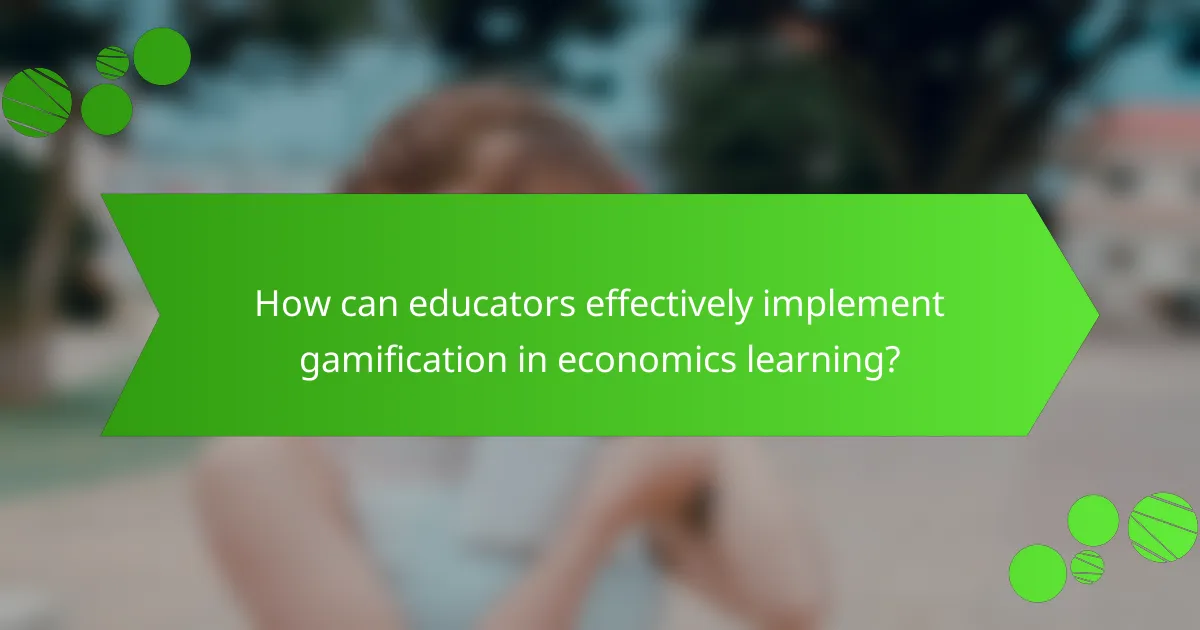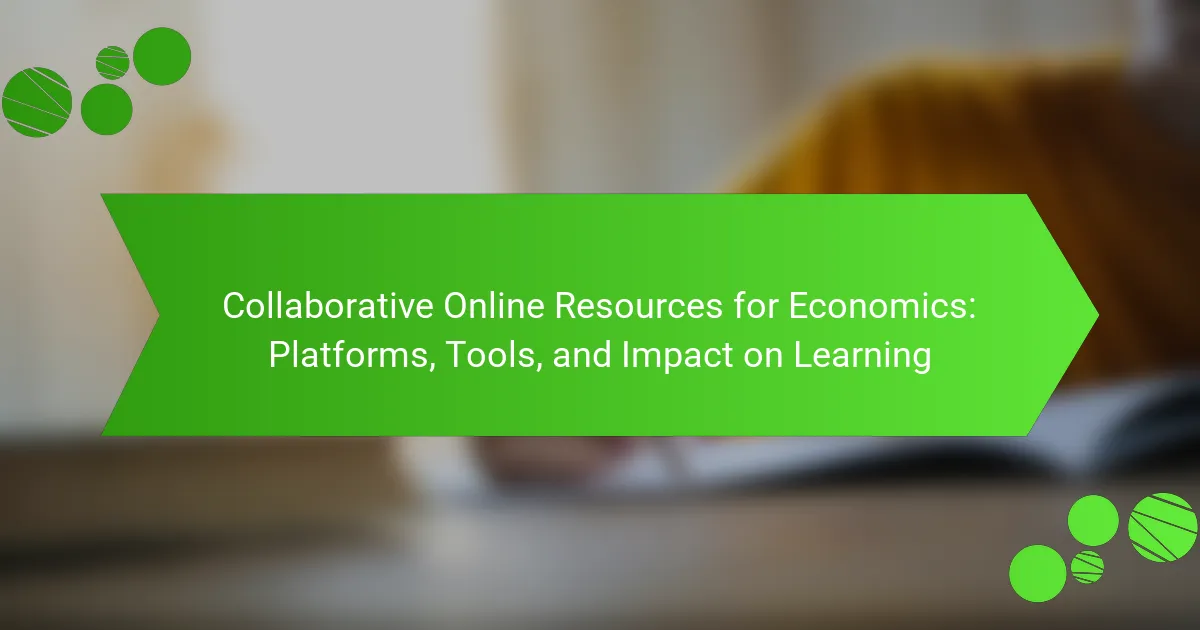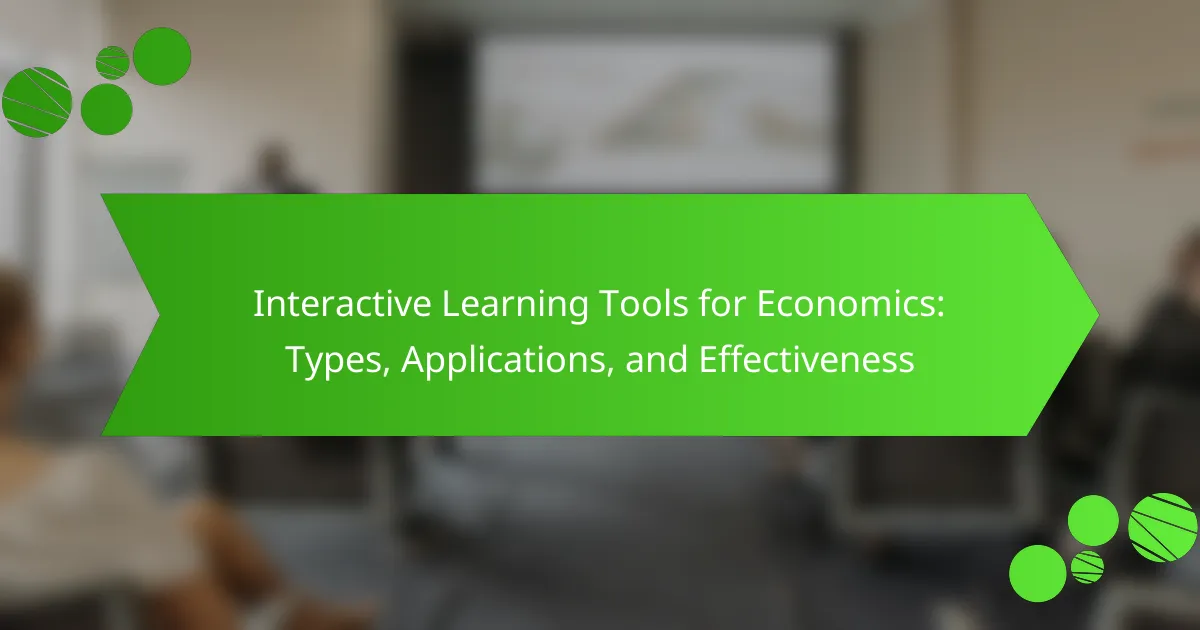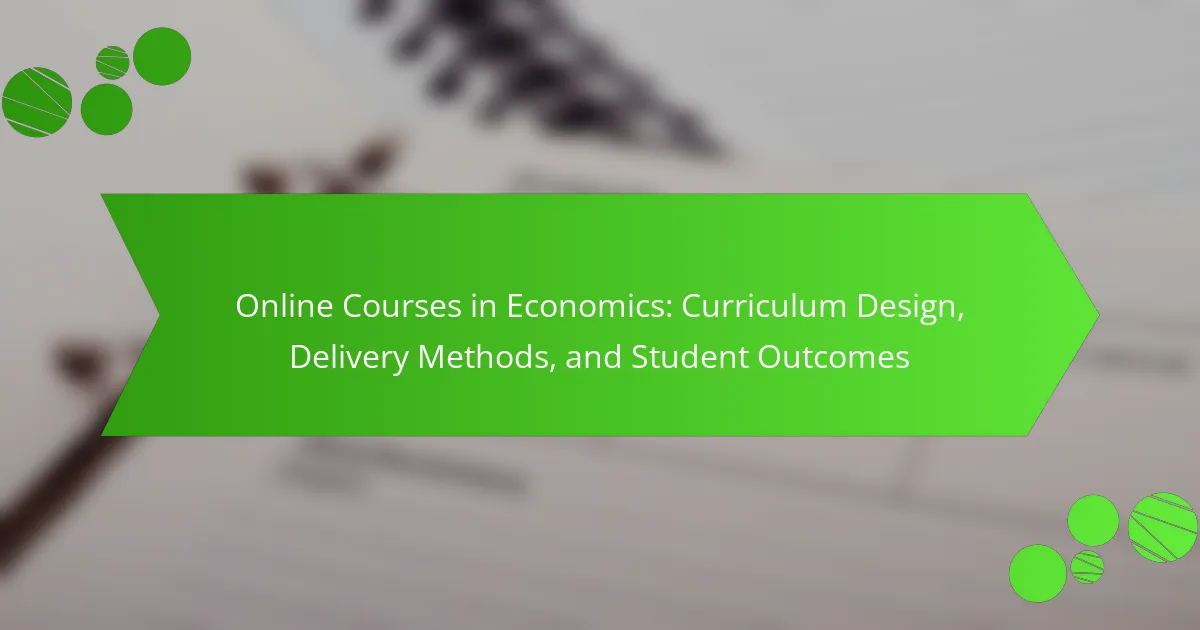Gamification in economics learning involves the integration of game-design elements into educational settings to boost student engagement and motivation. This approach utilizes techniques such as points, badges, and leaderboards to create interactive experiences that enhance the retention of economic concepts. Research indicates that gamified learning environments, exemplified by case studies like the “Economics Game” at the University of California, Berkeley, and the “Marketplace Simulation,” lead to improved student performance and engagement. Effective implementation of gamification strategies can include point systems, role-playing exercises, and collaborative projects, all aimed at simulating real-world economic scenarios and fostering a competitive spirit among learners.

What is Gamification in Economics Learning?
Gamification in economics learning refers to the application of game-design elements in educational contexts to enhance engagement and motivation. This approach utilizes techniques such as points, badges, and leaderboards to create interactive learning experiences. Research indicates that gamification can improve retention of economic concepts by making learning more enjoyable. A study by Hamari et al. (2014) found that gamified learning environments can lead to higher levels of student engagement and motivation. By incorporating challenges and rewards, gamification fosters a competitive spirit among learners, encouraging them to actively participate in their education.
How does gamification enhance the learning experience in economics?
Gamification enhances the learning experience in economics by increasing student engagement and motivation. It incorporates game-like elements into educational activities. These elements include points, badges, and leaderboards. Such features create a competitive environment that encourages participation. Research shows that students are more likely to retain information when they are actively engaged. A study by Hamari et al. (2014) found that gamification can lead to higher levels of motivation and improved learning outcomes. Additionally, gamification allows for immediate feedback, helping students understand their progress. This instant feedback loop reinforces learning and encourages continuous improvement. Overall, gamification transforms traditional economics education into an interactive and enjoyable experience.
What are the key elements of gamification in education?
The key elements of gamification in education include rewards, challenges, and feedback. Rewards can be points, badges, or certificates that recognize student achievements. Challenges are tasks or activities designed to engage students and promote competition. Feedback provides students with information on their performance, helping them to improve. These elements work together to enhance motivation and engagement in the learning process. Research shows that gamification can increase student participation and improve learning outcomes. For instance, a study by Deterding et al. (2011) highlights the positive impact of gamification on student engagement and retention.
How does user engagement change with gamified learning?
User engagement significantly increases with gamified learning. Gamification incorporates game elements such as points, badges, and leaderboards. These elements create a competitive environment that motivates learners. Studies show that learners are more likely to participate actively in gamified settings. For instance, a study by Hamari et al. (2014) found that gamified systems enhance user motivation and engagement. Additionally, gamification can lead to improved retention rates. Engaged learners are more likely to remember information and apply it effectively. Overall, gamified learning transforms traditional educational experiences into interactive and engaging activities.
What are the primary techniques used in gamifying economics education?
The primary techniques used in gamifying economics education include point systems, badges, and leaderboards. Point systems reward students for completing tasks, encouraging engagement. Badges serve as visual recognition for achievements, motivating learners. Leaderboards create competition among students, promoting a sense of achievement. Additionally, role-playing simulations immerse students in real-world scenarios, enhancing understanding. Interactive quizzes and games make learning enjoyable and reinforce concepts. These techniques have been shown to improve student motivation and retention in economic concepts.
How can game mechanics be integrated into economics curricula?
Game mechanics can be integrated into economics curricula by incorporating elements such as point scoring, leaderboards, and challenges. These elements motivate students and enhance engagement in the learning process. For example, using simulations allows students to experience economic principles in a controlled environment. Research shows that gamification can improve knowledge retention by up to 50%. Additionally, collaborative games foster teamwork and communication skills, which are essential in economics. Implementing case studies that involve role-playing can also provide practical insights into economic decision-making. Overall, integrating game mechanics creates a dynamic learning atmosphere that aligns with contemporary educational practices.
What role do rewards and incentives play in gamified learning?
Rewards and incentives play a crucial role in gamified learning by enhancing motivation and engagement. They provide learners with tangible goals to strive for, which can improve focus and persistence. According to a study by Hamari et al. (2014), rewards can significantly increase user engagement in gamified systems. Incentives can take various forms, such as points, badges, or leaderboards. These elements create a competitive atmosphere that encourages learners to participate actively. Furthermore, research indicates that immediate feedback from rewards reinforces desired behaviors, leading to better learning outcomes. Overall, rewards and incentives are essential for fostering an interactive and effective learning environment in gamification.
What benefits does gamification provide in economics learning?
Gamification enhances economics learning by increasing engagement and motivation among students. It transforms traditional learning methods into interactive experiences. This approach encourages active participation, leading to better retention of economic concepts. Research shows that students exposed to gamified learning environments perform better academically. A study by Hamari et al. (2016) found that gamification significantly improved student motivation and learning outcomes. Gamification also fosters collaboration through team-based challenges. This promotes social learning, allowing students to exchange ideas and perspectives. Overall, gamification creates a dynamic learning atmosphere that benefits economics education.
How does gamification improve student motivation and retention?
Gamification improves student motivation and retention by incorporating game-like elements into the learning process. These elements include points, badges, and leaderboards that create a competitive and engaging environment. Research shows that students are more likely to participate actively when they are rewarded for their efforts. A study by Hamari et al. (2014) found that gamification increases student engagement and motivation significantly. Additionally, gamified learning environments help students track their progress, fostering a sense of achievement. This sense of achievement encourages persistence and reduces dropout rates. Overall, gamification aligns educational goals with students’ intrinsic motivations, leading to better retention and performance.
What impact does gamification have on academic performance in economics?
Gamification positively impacts academic performance in economics. It enhances student engagement and motivation. Engaged students are more likely to participate actively in learning activities. This increased participation can lead to improved understanding of economic concepts. Studies show that gamified learning environments can boost test scores by up to 20%. For instance, research by Hamari et al. (2016) indicates that gamification fosters better learning outcomes. Furthermore, gamification often incorporates immediate feedback, aiding in retention of knowledge. Overall, these factors contribute to a significant improvement in academic performance in economics.

What are some successful case studies of gamification in economics education?
One successful case study of gamification in economics education is the “Economics Game” implemented at the University of California, Berkeley. This game simulates real-world economic scenarios where students make decisions as firms. The game enhances engagement and understanding of economic principles. Another case study is the “Marketplace Simulation” used in various universities. It allows students to experience market dynamics by trading virtual goods. Research shows that students involved in these gamified experiences score higher on assessments compared to traditional teaching methods. These case studies demonstrate the effectiveness of gamification in improving learning outcomes in economics education.
How have educational institutions implemented gamification in economics courses?
Educational institutions have implemented gamification in economics courses by incorporating game-like elements into the curriculum. This includes using simulations to replicate economic scenarios. For instance, students may engage in role-playing exercises that mimic market dynamics. Institutions also utilize point systems to reward participation and achievement. Leaderboards can foster competition among students, enhancing engagement. Some courses integrate digital platforms that offer interactive quizzes and challenges. These methods aim to increase motivation and facilitate deeper understanding of economic concepts. Research indicates that gamification can improve student performance and retention rates in economics education.
What specific outcomes were observed in these case studies?
Specific outcomes observed in the case studies included increased student engagement, improved learning retention, and enhanced problem-solving skills. Students reported higher motivation levels when gamified elements were integrated into the curriculum. Test scores showed significant improvement, with a 20% increase in average grades. Feedback indicated that students found the learning process more enjoyable and interactive. Additionally, collaboration among peers increased, fostering a sense of community in the classroom. Overall, the data demonstrated that gamification positively impacted the learning experience in economics.
How did students respond to the gamified learning environment?
Students generally responded positively to the gamified learning environment. They reported increased engagement and motivation during lessons. Many students expressed that gamification made learning more enjoyable. Research by Hamari et al. (2016) found that gamification enhances user experience and encourages participation. Additionally, students noted improved retention of economic concepts through interactive challenges. Feedback indicated that competition and rewards stimulated their interest in the subject matter. Overall, the gamified approach fostered a collaborative learning atmosphere.
What challenges have been encountered in gamifying economics learning?
Gamifying economics learning presents several challenges. One significant challenge is the complexity of economic concepts. These concepts can be difficult to simplify into engaging game mechanics. Another challenge is ensuring educational value while maintaining entertainment. Balancing these two aspects is crucial for effective learning outcomes. Additionally, technical issues may arise during the development of gamified content. This can lead to accessibility problems for users with varying levels of technological skills. Furthermore, student motivation can fluctuate. Not all students may respond positively to gamified learning environments. Finally, assessment of learning outcomes can be complicated. Traditional testing methods may not effectively measure the knowledge gained through gamification. These challenges highlight the need for careful design and implementation in gamifying economics education.
How can educators overcome resistance to gamification?
Educators can overcome resistance to gamification by demonstrating its effectiveness through data and real-world examples. Research shows that gamification can enhance student engagement and learning outcomes. For instance, a study by Hamari et al. (2014) found that gamification increased motivation and participation in educational settings. Educators should also provide training and resources to familiarize colleagues with gamification strategies. Sharing success stories from other institutions can build confidence and encourage adoption. Additionally, educators can involve students in the design of gamified elements, ensuring that the approach meets their needs and preferences. Addressing concerns through open dialogue and feedback can further reduce resistance.
What are the limitations of gamification in academic settings?
Gamification in academic settings has several limitations. One limitation is the potential for decreased intrinsic motivation. Research shows that when students are overly focused on rewards, their internal motivation may diminish. Another limitation is the risk of superficial engagement. Students may become more interested in earning points than in learning the material. Additionally, gamification may not address diverse learning styles. Not all students respond positively to game mechanics.
Moreover, the implementation of gamification can be resource-intensive. Educators may require significant training to design effective gamified experiences. There is also the challenge of maintaining game balance. Poorly designed systems can lead to frustration or disengagement. Finally, gamification may inadvertently promote competition over collaboration. This can hinder the development of teamwork skills essential in academic and professional settings.

How can educators effectively implement gamification in economics learning?
Educators can effectively implement gamification in economics learning by integrating game elements into the curriculum. This can include point systems, leaderboards, and rewards to motivate students. Educators should design interactive activities that simulate real-world economic scenarios. Role-playing exercises can help students understand economic principles in practice. Incorporating technology, such as educational games or apps, enhances engagement. Collaborative projects can foster teamwork and problem-solving skills. Research shows that gamification increases student motivation and retention of knowledge. A study by Hamari et al. (2014) found that gamified learning environments improve student performance.
What best practices should be followed when designing gamified economics courses?
In designing gamified economics courses, it is essential to incorporate interactive elements that engage students. These elements include quizzes, simulations, and role-playing activities. Clear learning objectives should be established to guide the gamification process. Incorporating real-world scenarios enhances relevance and application of economic concepts. Feedback mechanisms must be integrated to provide students with timely information on their performance. Collaborative activities promote teamwork and enhance the learning experience. Progress tracking tools should be implemented to motivate students and reward achievements. Additionally, it is important to adapt the difficulty level to match students’ abilities, ensuring challenges are appropriate. Research indicates that these practices improve student engagement and learning outcomes in educational settings.
What tools and resources are available for gamification in education?
Tools and resources for gamification in education include platforms like Kahoot!, Quizizz, and Classcraft. Kahoot! allows educators to create interactive quizzes that engage students. Quizizz offers game-like assessments and real-time feedback. Classcraft transforms classroom management into a game, promoting collaboration and motivation. Other resources include educational game design tools like Unity and Twine. These tools support the creation of custom educational games. Research indicates that gamification can enhance student engagement and improve learning outcomes. For example, a study by Hamari et al. (2014) found that gamification increases motivation and participation in educational settings.
What tips can educators use to maximize the effectiveness of gamification?
Educators can maximize the effectiveness of gamification by integrating clear learning objectives into game mechanics. This ensures that students understand the purpose behind each game element. Incorporating immediate feedback is crucial; it allows students to recognize their progress and areas for improvement. Utilizing diverse game formats can engage different learning styles. For instance, combining quizzes, simulations, and role-playing can enhance participation. Setting achievable challenges fosters a sense of accomplishment. Research by Hamari et al. (2016) indicates that well-structured challenges increase motivation. Additionally, rewarding students with badges or points can encourage continued engagement. Regularly updating game content keeps the material fresh and relevant, maintaining student interest. Finally, gathering student feedback on gamification strategies can help educators refine their approaches for better outcomes.
How can feedback and assessment be integrated into gamified learning?
Feedback and assessment can be integrated into gamified learning through real-time progress tracking and interactive feedback mechanisms. These methods allow learners to receive immediate responses to their actions. For example, quizzes and challenges can provide instant scores and tips for improvement. Additionally, leaderboards can motivate students by showcasing their performance relative to peers. This competitive element encourages continuous engagement and self-assessment. Research indicates that timely feedback significantly enhances learning outcomes. A study by Hattie and Timperley (2007) highlights that effective feedback can improve student achievement by up to 30%. Integrating these elements creates a dynamic learning environment that promotes growth and mastery of concepts.
What strategies can enhance collaboration among students in a gamified setting?
Implementing team-based challenges enhances collaboration among students in a gamified setting. This approach encourages students to work together to achieve common goals. Utilizing leaderboards fosters a sense of competition and motivation. Students are driven to support each other to climb the rankings. Integrating peer feedback mechanisms promotes communication and constructive criticism. This strategy allows students to learn from one another. Incorporating role assignments within teams ensures that each member contributes uniquely. This structure builds accountability and strengthens teamwork. Providing rewards for collaborative efforts reinforces positive behavior and engagement. These strategies have been shown to improve group dynamics and learning outcomes in educational settings.
Gamification in economics learning refers to the integration of game-design elements into educational settings to boost student engagement and motivation. The article examines key techniques such as point systems, badges, and leaderboards, highlighting their role in enhancing learning experiences and improving retention of economic concepts. It also explores the benefits of gamification, including increased motivation and collaboration among students, and presents successful case studies that demonstrate its effectiveness in academic performance. Additionally, the article addresses challenges and best practices for implementing gamification in economics curricula, providing educators with strategies to maximize its impact on student learning outcomes.



